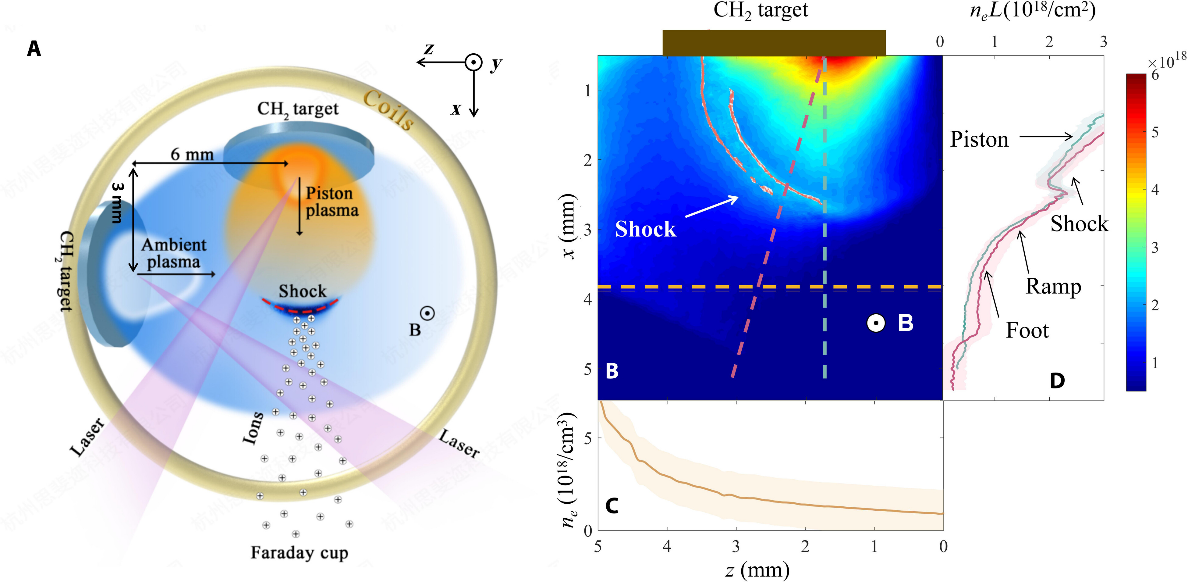Researchers from the University of Science and Technology of China (USTC) achieved the first direct laboratory observation of ion acceleration through reflection off laser-generated magnetized collisionless shocks. This observation demonstrates how ions gain energy by bouncing off supercritical shocks, central to the Fermi acceleration mechanism. The research was published in Science Advances.
Collisionless shocks are cosmic powerhouses responsible for accelerating charged particles to extreme energies. This acceleration involves particles repeatedly crossing shock fronts, gaining energy incrementally. However, how do particles initially gain enough energy to enter this cycle? Two competing theories, shock drift acceleration (SDA) and shock surfing acceleration (SSA), have emerged, but observational limitations in space and previous lab experiments have left the question unresolved.

Laser-driven magnetized collisionless shock experiments(Image from Hui-bo Tang et al)
This new experiment, conducted at China’s Shenguang-II laser facility, recreated a controlled astrophysical shock scenario. Researchers used high-energy lasers to generate a magnetized ambient plasma and a supersonic “piston” plasma. When the piston collided with the ambient plasma at speeds exceeding 400 km/s, it produced a supercritical quasi-perpendicular shock, similar to those observed near Earth. Advanced diagnostics, including optical interferometry and ion time-of-flight measurements, captured the shock’s structure and ion dynamics. The team observed a quasi-monoenergetic ion beam streaming upstream at 1,100–1,800 km/s, two to four times the shock velocity. This fast ion component mirrored signatures detected in Earth’s bow shock but with unprecedented clarity.
Key to the discovery were particle-in-cell simulations, which tracked ion trajectories and electromagnetic fields. The simulations revealed that reflected ions gained energy primarily through the shock’s motional electric field—a hallmark of SDA. During reflection, ions interacted with both the shock’s electrostatic field and the compressed magnetic field, accelerating along and perpendicular to the shock front. This dual acceleration mechanism produced a distinct high-velocity ion beam. Notably, the experiment’s magnetic field strength (5–6 Tesla) and plasma conditions bridged the gap between previous lab studies and astrophysical shocks, enabling direct comparison with space observations. Critically, the results ruled out SSA as the dominant process, settling a decades-old debate.

Ion velocity spectra in experiments and 1D PIC simulations(Image from Hui-bo Tang et al)
By confirming SDA’s role in ion injection, the study validates models used to interpret cosmic ray origins and supernova remnants. Moreover, the experiment’s design—a reproducible, tunable shock platform—offers a new tool for studying high-energy particle dynamics under controlled conditions. Potential applications include optimizing laser-driven ion accelerators, where magnetic fields could enhance beam quality, and improving inertial confinement fusion by mitigating shock-induced instabilities.
This breakthrough not only advances our understanding of universal particle acceleration but also demonstrates how laboratory experiments can complement space exploration. As researchers refine these methods, future studies may unravel how repeated reflections create the extreme energies seen in cosmic rays, bringing humanity closer to decoding the universe’s most powerful accelerators.
Paper link: https://www.science.org/doi/10.1126/sciadv.adn3320
(Written by WU Yuyang, edited by ZHAO Zheqian, USTC News Center)